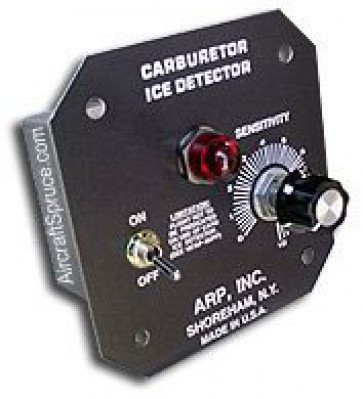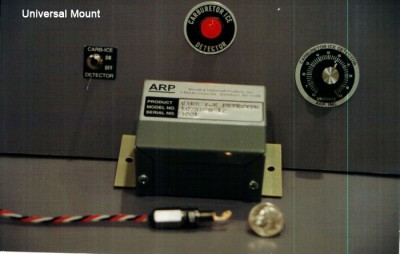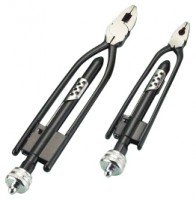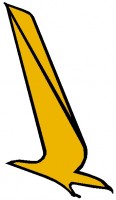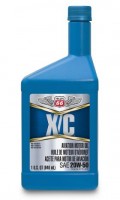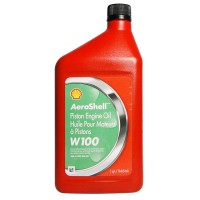Aircraft Spruce Canada
Brantford, ON Canada
Corona, CA | Peachtree City, GA
Chicago, IL | Wasilla, AK
Arp Carburetor Ics Dect 12V 107AP-12
MFR Model# 107AP 12V
Overview
|
CARBURETOR ICE of the is one most dangerous as well as most common problems that pilots encounter because it can strike anyone just about anywhere during all phases of flight.
ARP CARBURETOR-ICE DETECTION SYSTEMS are made in USA and have been in service since 1967. In fact, ARPs carburetor-ice detectors are the Original optical detectors on the market. They are available in three (3) different mounting configurations (Panel Mount, Remote Mount and Universal Mount) thus providing flexibility for any aircraft installation. DETECTS FROST / ICE CRYSTAL (NOT TEMPERATURE) by placing an optical probe upstream in the most ice prone area of the carburetor air stream the carburetor venturi. ARP carburetor-ice detectors detects actual frost / ice crystal formation well in advance before any problems can occur. This type of system is much more reliable than temperature indicators which cannot compensate for temperature / moisture ratios. GIVES UP TO 5 MINUTES WARNING TIME by illuminating a RED visual ice warning light once ice formation occurs inside the carburetor thus providing the pilot sufficient time to apply carburetor heat before loss of engine performance. HIGHLY RELIABLE with over 30 years of proven field performance. LIGHT WEIGHT less than 13 ounces thus no impact on weight and balance. SIMPLIFIED INSTALLATION keeps installation cost down approximately 1 to 3 man-hours. TWIN ENGINE APPLICATIONS are achieved by using individual ice detector systems for each engine. SAVES FUEL by avoiding unnecessary use of carburetor heat. WARRANTY 3-Years on Electronics Box and 1-Year on Probe. FAA-STC SA489EA APPROVED for normal, utility and acrobatic airplanes and helicopters equipped with Continental, Franklin and Lycoming type engines and Precision Air-Motive (Facet or Marvel-Schebler) MA-2, MA-3, MA-3A, MA-3SPA, MA-4, MA-4-5, MA-4SPA, MA-5, MA-6, MA-6AA and HA-6 series carburetors. Installation on other aircraft not specified on the STC may be performed via FAA Form 337. FAA-PMA APPROVED for installation on Type Certificated aircraft.
Instrument Dimensions:
PANEL MOUNT CONFIGURATION
Instrument Dimensions: |
Reviews
I would not fly without it. A week before Christmas we were flying over the mountains from Nashville to coastal NC in a 172 with two teenagers and wife. (Dropped fuel no luggage- 100lbs under gross) VFR. Hazy 35 deg oat spotty light rain no ice. Detector indicated ice formation 3 times over mountains. Carb heat applied before any drop in rpm. This would not have been a good time to be dealing with carb ice or loss of altitude. I strongly recommend on carb engine. 6 stars if I could. K.P.
Simply put, if you own an aircraft with a carbureted engine this is MUST have equipment. And YES it works as advertised. You know immediately if you have anything forming in the carb, and with properly applied heat, its gone before the engine ever saw it. Cant believe this isnt standard equipment. I use on carbureted 182 and would never fly without it again.
I’ve had one of these for 20 years in my Grumman Tiger .No false readings. Saved my bacon on a number of occasions including just recently skirting a thunderstorm returning to Michigan from California. Carb ice is very sneaky and this will detect it long before the engine runs rough or stops!
I’ve been using it for half a year. I think this is the most important device for a carburetor engine.
Not enough stars for this device. It has warned me several times. But only using carb heat as needed saves engine wear as its unfiltered air going into engine while using carb heat
I had one of these in a 172. This is really the only way to go if you fly a carbureted engine. There is absolutely no guesswork. You know when ice is starting to build in the venturi. Our Comanche has a temp. gage. That will be replaceded by this unit when it arrives.
I use this detector and it works great. My Cessna 150 gets carb ice and this device shows when it happens. I just pull carb heat until the lamp goes out. Yesterday I was over mountain and big trees and the lamp start showing. I took care of the building ice and my engine didn't miss a beat. I think having one is a safety tool for ice makers such as a Continental O-200 engine. -- Keep your wings level and fly right..
I use one of these in my Cessna 180. Over 19 years, it's warned me only when there's been actual carb ice. I regard it as a must have for carbureted engines.
Q&A
Please note, Aircraft Spruce Canada's personnel are not certified aircraft mechanics and can only provide general support and ideas, which should not be relied upon or implemented in lieu of consulting an A&P or other qualified technician. Aircraft Spruce Canada assumes no responsibility or liability for any issue or problem which may arise from any repair, modification or other work done from this knowledge base. Any product eligibility information provided here is based on general application guides and we recommend always referring to your specific aircraft parts manual, the parts manufacturer or consulting with a qualified mechanic.
Per the manufacturer: Yes, this unit can be mounted behind the panel in a standard 3-1/8 inch hole.
It is recommended to use the probe provided with this product. we have no data to support the use of other probes.
This unit only gives you a visual warning with a red light.
Less than 1 amp draw and you would use a 1.5amp fuse.
The probe has a 12 inch lead.
The probe is included with this.
The correct p/n for a 24/28v aircraft is 10-07363. The current draw is less than 1 amp. Part has an in-line fuse and requires at least a 1.5 amp breaker.

 Aircraft Spruce Canada
Aircraft Spruce Canada
